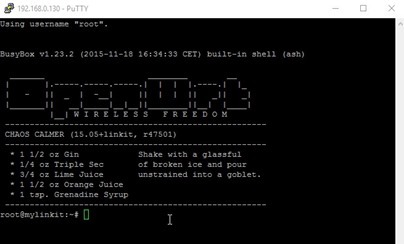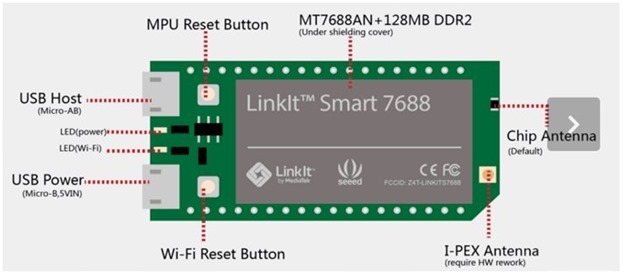This is interesting… so in the post between Christmas and New Year I received one of these in the post. The Linkit Smart 7688 arrived in the form of a small box about the size of a box of matches. The unit itself is a PCB with metal screen (note the various CE and FC marks for those interested) and is around 25mm by 58mm.
 Like many others, I’m lazy so I only half read the instructions. This WIFI-enabled tiny unit has a built-in router for setup – no, not just a couple of pages setup – a full OpenWrt router with web interface! Well that was the first issue – just plug it into your computer, select the WIFI access point and you’re off – except that my computer doesn’t have WIFI – why would it – it’s a desktop computer! So got the phone out instead.
Like many others, I’m lazy so I only half read the instructions. This WIFI-enabled tiny unit has a built-in router for setup – no, not just a couple of pages setup – a full OpenWrt router with web interface! Well that was the first issue – just plug it into your computer, select the WIFI access point and you’re off – except that my computer doesn’t have WIFI – why would it – it’s a desktop computer! So got the phone out instead.
I plugged the unit into USB power (there is also a host mode connector for attaching memory sticks etc) and around 30 seconds later a new access point appeared on my phone – and I selected it. The online instructions give an access point IP address of 192.168.100.1 so I picked that. Sure enough – on the phone I got a really pretty screen asking me for a new admin password which I promptly gave.
The next step was to upgrade the software from the MediaTek labs website – that would have involved transferring a file to my phone after downloading it onto the PC – thankfully the software on the board was fully up to date – so that was that step sorted.
 The next step involved getting PUTTY on a PC to talk to the board. Well, the PC of course was on the hardwired network – while the little board had it’s own local address so that wasn’t going to work.
The next step involved getting PUTTY on a PC to talk to the board. Well, the PC of course was on the hardwired network – while the little board had it’s own local address so that wasn’t going to work.
On the mobile phone display I noted a link to OpenWrt – so I followed that and sure enough this tiny little board has a normal-looking router on it (well, normal for something much bigger) – I have to say I was well impressed!
Next: get the unit running on my network – it turns out that was easy enough – I selected client mode and put in the password for my network and the next thing I knew I was looking at a Linux PC accessed by WinSCP – amazing – you could fit at least 3 of these into the space of a Raspberry Pi!!
 Of course you were supposed to do all of this with Putty but I’m used to WinSCP – which has Putty attached to it – would it be that simple? – invoke Putty from WinSCP as usual? I clicked the button and…
Of course you were supposed to do all of this with Putty but I’m used to WinSCP – which has Putty attached to it – would it be that simple? – invoke Putty from WinSCP as usual? I clicked the button and…
Yes, it WAS that easy. Don’t ask me what all that stuff about drinks is on the right – someone’s sense of humour I would think. The important point is that this is a Linux command prompt.
Anyway, armed with the built-in shell, I decided for once to follow the instructions. This thing has PYTHON built into it and so..
python /IoT/examples/blink-gpio44.py – hit ENTER – and didn’t the light start flashing!
In the examples directory I found this..
import mraa
import timex = mraa.Gpio(44)
x.dir(mraa.DIR_OUT)while True:
x.write(1)
time.sleep(0.2)
x.write(0)
time.sleep(0.2)
So I tried messing with the example and sure enough I could alter the timing and re-run within seconds.
So right now we have a REALLY easy way to flash a light…. for around £7 or 8 that’s a tad expensive – but of course that’s just the beginning…
Here’s the spec.
580Mhz MIPS CPU
WIFI
Pin-outs for GPIO.,I2C,I2S,SPI,UART,PWM and Ethernet Port.
32MB of Flash and 128MB of DDR2 RAM
USB Host
Micro SD slot
 There is a breakout board for this and as you can see it does have a proper Ethernet connector. There are also a host of other add-ons but I’ll leave you to go off to SEEED’s website if you’re interested in more.
There is a breakout board for this and as you can see it does have a proper Ethernet connector. There are also a host of other add-ons but I’ll leave you to go off to SEEED’s website if you’re interested in more.
http://www.seeed.cc/linkit_smart_7688/
The unit runs OpenWrt Linux (I’ve not tried expanding it with the MicroSD card underneath so I’m just using it right now as it comes out of the box). You can program in Python, Node.JS (which is why I’m interested) and C.
Rather than me rant about other features and the video etc… here’s the link. http://www.seeedstudio.com/depot/LinkIt-Smart-7688-p-2573.html
And yes, it has NPM!
The next model up (7688 DUO) has an MCU and can be programmed in C using the Arduino setup – so there is something here for both beginners and advanced programmers.


Someone tried to use MRAA I2C ?!!! I did not make it !
Hi Pete. Regarding the Duo version, is there any downside to having the linux based openWRT distro running on one chip and the arduino compatible stuff on the ATmega chip? I understand that linux is not a RTOS and was just wondering if problems on the linux side could ever interfere with mission critical stuff on the arduino compatible side such as reading the state of pins etc.
How long is a piece of string Steve – sure it will be somewhat slower than the Arduino due to multi-tasking – but not THAT slow – it kind of depends what you’re doing on the arduino side – and of course there are interrupts.
Interesting ! … it leads me to order one, even if I have some Domino.io already.
Well, you had one up on me there Martin…. they look good – but how well do they work (The Dominos)?
The Dominos ? They work fine. They are using Atheros AR9330, but RAM is only 64M and Flash is only 16MB. I’ve purchased them thru a Kickstarter campaign. Although the campaign succeeded, I think they didn’t sold that much, because the community is pretty quiet, 1 or 2 post per week. I have the feeling that Mediatek LinkIt module will probably gain much more traction.
I’ve just received my LinkIt 7688 today and just started to play with it.
Huge memory, SD card, etc. Plenty of things to explore.
But I found the lack of STA+AP mode disappointing …
Peter, did you see a black swift? https://www.kickstarter.com/projects/1133560316/black-swift-tiny-wireless-computer
Referred to I believe as the Unwired One. I am awaiting a response from the company – thought it might be a good idea to review one here…
There’s a (fairly old, but workable) mosquitto package available for it, as well as the mosquitto_clients (mosquitto_sub and mosquitto_pub command-line I/F clients). I’m currently running them on a tiny WR703N pocket router as a backup server (mostly just for testing ESP clients).
I should be more specific …by “for it” I meant OpenWRT, not the Linkit 7688 specifically.